Posted - 08/16/2016 Finding Our Form -- Innovation Ecology’s ‘Pause’
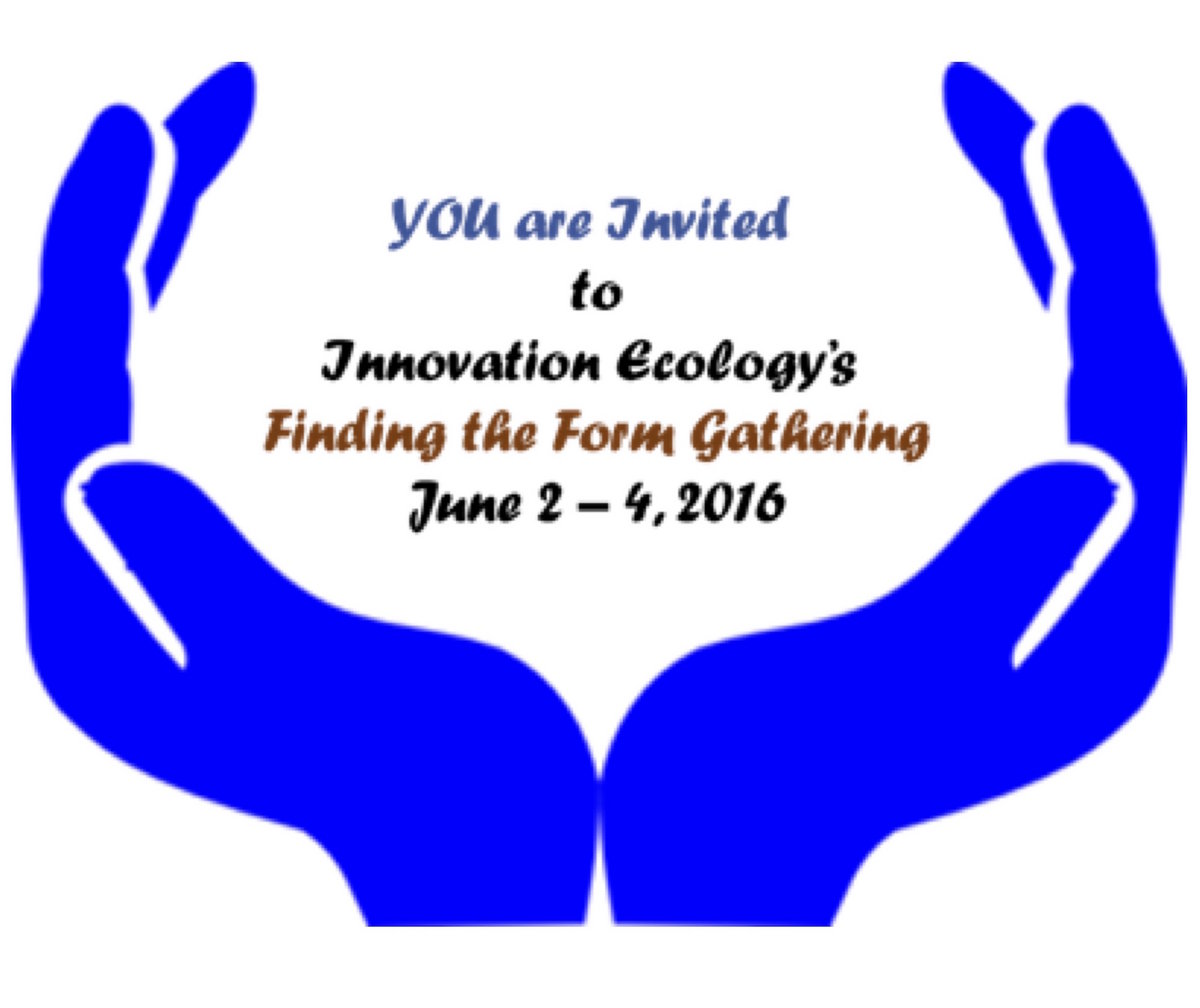 By 2016 Invoking the Pause Grant Partner ARC:KE:i
By 2016 Invoking the Pause Grant Partner ARC:KE:i
"I try not to find the form too soon. Instead I try to think about it as an idea without a shape."
Maya Lin, Boundaries. New York. 2000.
Here in the Pacific Northwest, someone seeking to pause, to reflect, might be said to be 'stepping out of the river.' Our rivers, including the mighty Columbia, have shaped and continue to shape our language and culture, as do the geographic features of so many communities around the globe. Why step out of the river? A fish in a river does not know it is in a river because the river surrounds it. Only by being out of the river can the fish see the eco-system in which the river exists, with its dynamic balance of destructive and creative forces. We sought a Pause to see Innovation Ecology's contextual system: the essential 'bridge' between the hard and soft systems that accelerates communication and learning by communities working towards resilient, low-carbon futures. Our aim was bringing our seed concept into a flowing, self-nourishing reality capable of supporting communities in the critical work they must do together to thrive.
We called it a gathering and we set it in the orchards just south of Hood River, a Columbia River Gorge town nestled between two mountains (Mt. Adams to the north and Mt. Hood to the south), at the point where the wet west blurs into the dry east. The Gorge is an incredibly diverse place, linking not only east and west sides of the Cascade Mountain range, but also urban and rural points of view, new and venerably old cultures. It holds the long memory of the land, a story told and re-told across peoples and time.
Our primary meeting/living room

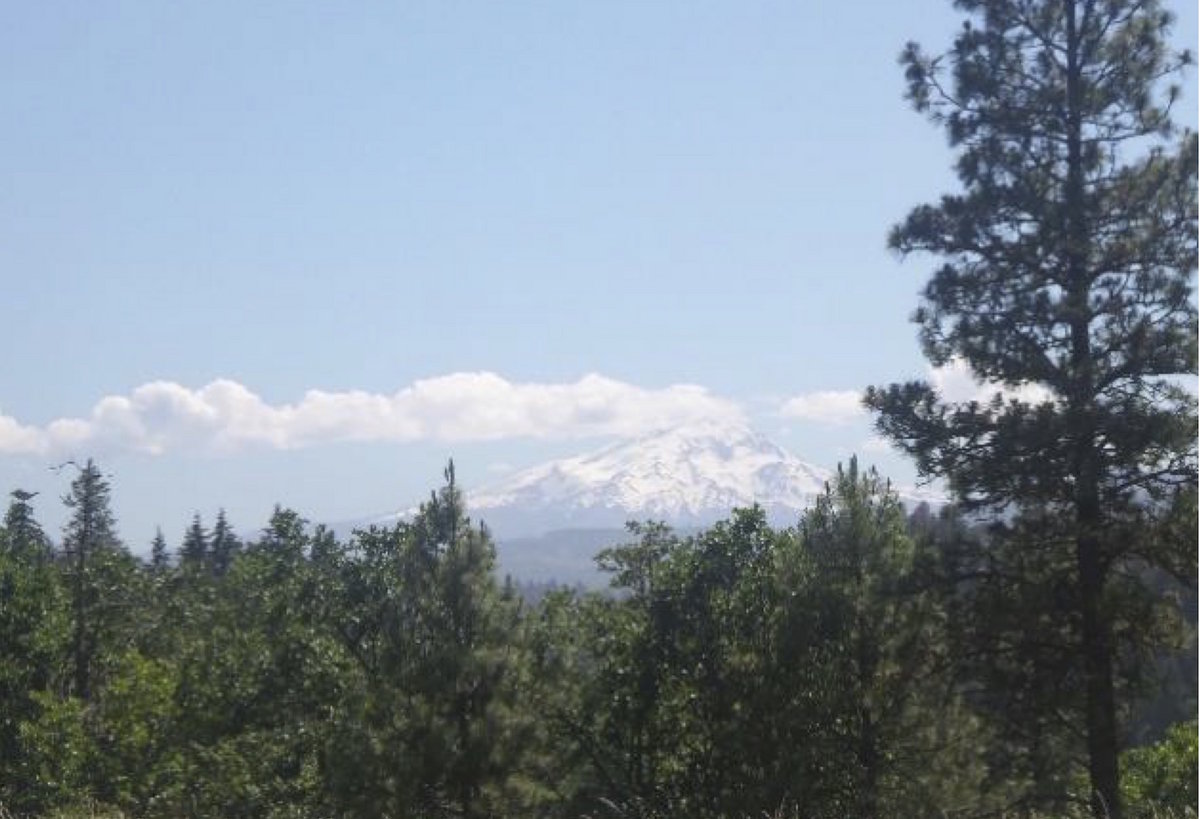
The view from the main house
Who came?
Using the strategic leverage points from a clean energy systems map developed through the participation of over 30 organizations focused on clean energy in the Columbia River Basin, we looked for people in our networks that could bring us those specific perspectives. The table below captures the leverage point elements and the people attending.1| Clean Energy System Leverage Point | Attendee |
| Regenerative economy | Dara Blumenthal, Christina Bowen, Kathryn Langstaff |
| People starting clean energy/regenerative businesses | Rick Turoczy, Sam Pardue, Sarah Berg |
| Technology supporting clean energy/regenerative action | Jeff Mohr, Philip Pridmore-Brown, Christina Bowen |
| Community leadership for clean energy/regenerative action | Jerry Millhon, Elizabeth Woody, Aaron Moore, Erica Bryant, Bill Weiler |
| Public awareness of the benefits of clean energy/regenerative action | Maggie Starr, Aaron Moore, Erica Bryant, Colin Fogarty |
| Market demand for clean energy/regenerative action technology | Rick Turoczy, Sam Pardue, Sarah Berg |
| Investment in clean energy/regenerative action | Kathryn Langstaff, Rick Turoczy |
| Policies supporting clean energy/regenerative action | Pamela Morgan |
But the table does a poor job showing the richness of our gathering's participants. This is best seen on the map we made to help everyone attending get to know the others. Below is a picture of our map, although it comes to 'life' only if viewed live, which you can do by clicking here.
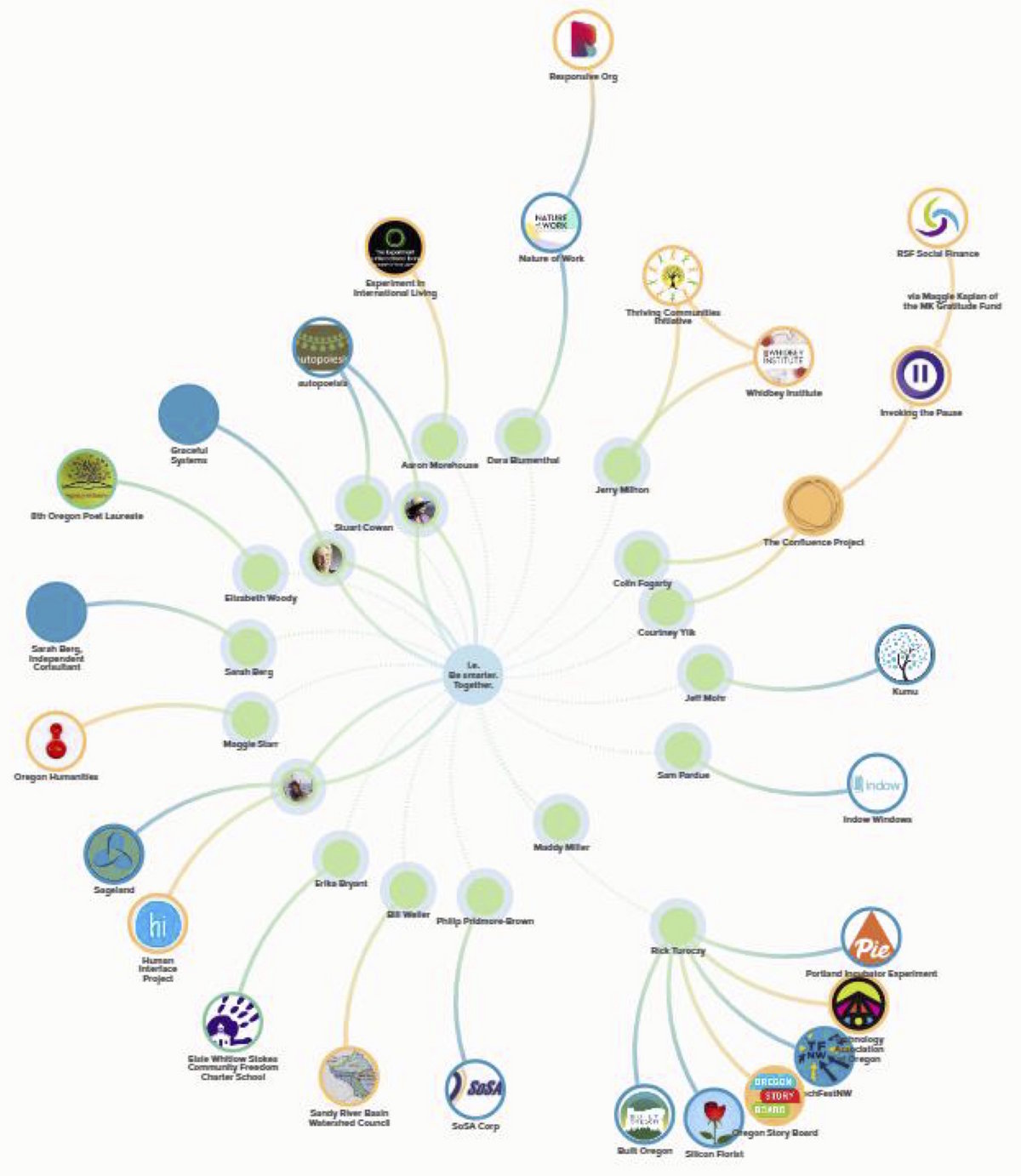
Through another version of this map, we explored the connections between our gatherers. Again, this is best viewed live, which you can do here. In 'live' mode, selecting any one or more of the "purposes" gleaned from our gatherers' websites - learning, software, social justice, story-telling, and flourishing economy - reveals who connects to that purpose. We are including a picture of the connections shown when one highlights all of the purposes:
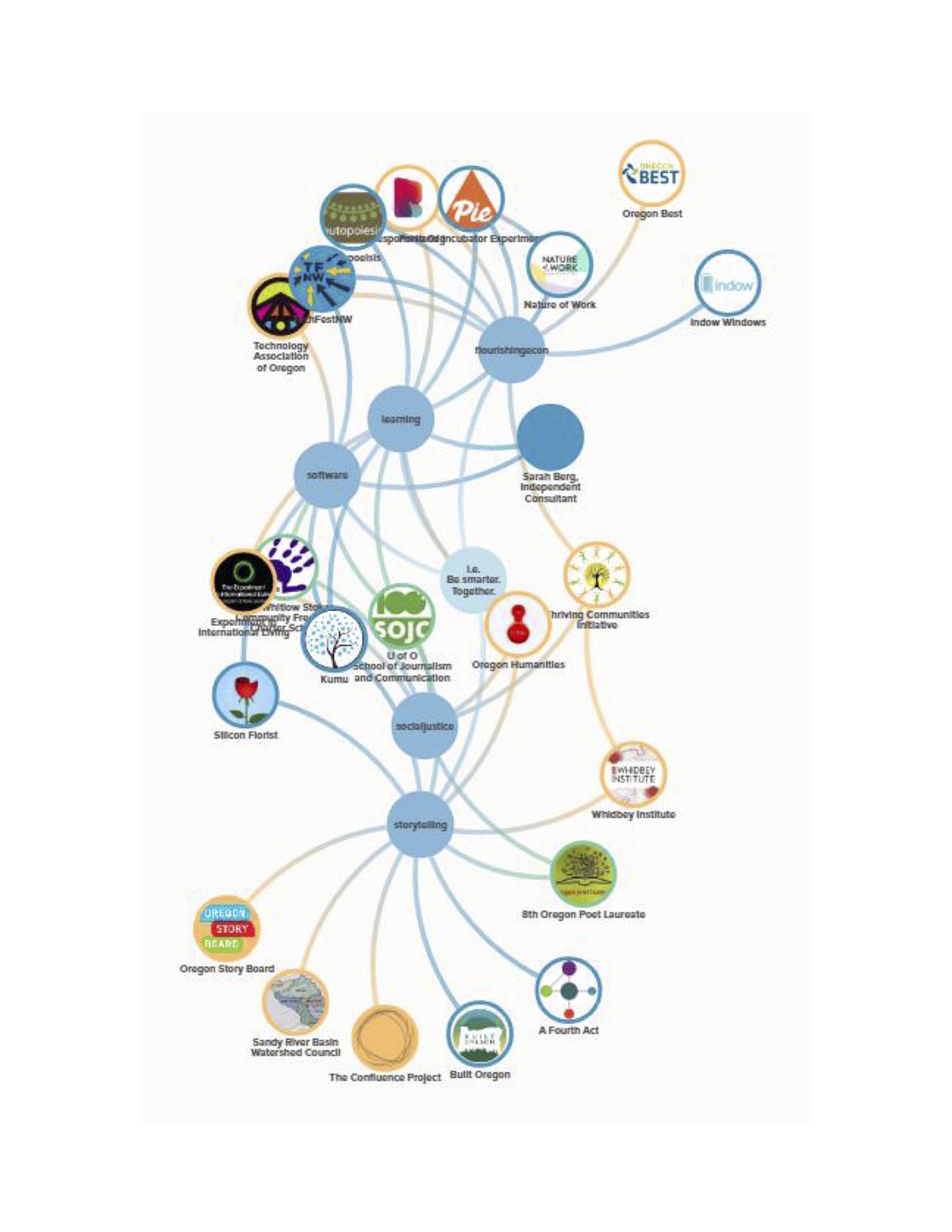
Where did we start?
We started the gathering with a hike to a uniquely meaningful spot along the Columbia River: the bird blind designed by Maya Lin and managed by the Confluence Project, our sponsor for the ITP grant. The bird blind sits at the confluence of two rivers - the Sandy and the Columbia. The Sandy River is undergoing tremendous change with the removal of an over 100-year-old dam and the confluence area itself has received much loving attention. The bird blind records the presence of wildlife at the time Lewis and Clark explored the Columbia for President Jefferson and the presence - or absence - of that life today. Its design also provides a dramatic experience in what happens to one's vision when you step back from an up-close focus on individual things (in this case, the slats of the blind). From the center of the structure, an arcing view appears of the landscape outside the blind. It is quite magical and grounded all of us in our task for the next two days: to step back and explore the 'system' in which Innovation Ecology could flourish in its mission.
Once we had all 'gathered', Elizabeth Woody - Oregon's 8th Poet Laureate - opened our gathering with one of her poems, shared here:Twanat
Blue Moonlight in swooped clouds thin to dark eagles mating
In crosses of elliptical loops.
Beating pulses synchronize heartbeats among the tulee reed longhouses.
An old wound in the land healed over years of corruption and charging horse soldiers. The children ran over the embankment.
Alarms were frantic pounding of hooves and rifles. In the spirits silent rising and cracking bones. The valley courses with Nee Mee Poo souls.
At times one hears music in the leaves. It is light and tinkles of shell. Rapture.
Run off torrents with moonlight ice. Exhale. Breathe deep, organ pipes moan under the ribs from church.
The ancestors sing despite conversion.
6
This is not one voice but the beginning of all voices in unison. Yes, crescendo waves of spiral utterances of the Plateau canyons. Blue herons rise.
The river returns pervasive with silver and red Nusoox.
© 2014 Elizabeth Woody
Ichiskiin words:
Twanat means to follow, as in ancestral teachings, cultural lifeways
Nee Mee Poo are Nez Perce
Nosoox means salmon
This is not one voice. Indeed. That and the other thoughts Twanat expresses so beautifully opened our gathering with just the right spirit.
What did we do?
Gathering participants joined in structured conversations, open space conversations, and causal map exploration, as well as exercises based on aikido, qigong and other reflection and movement time. Several insights emerged from engaging the group in the barriers and enablers involved with 'accelerating communities of place and practice in learning to frame questions, take resilient action, and forge collaborative innovation networks in the face of climate change.' Building on the leverage points listed above from our 2015 effort to map the system from which communities with resilient, clean energy systems might emerge (found here and explained in a presentation here), participants identified:| Enablers | Barriers |
| Visible feedback on the state of important outcomes, supporting innovation, and recognition of pain that can lead to collaboration | Economic sectors dependent on both climate stability and fossil fuels, such as winter sports and agriculture |
| Use of a common language and lexicon, supporting trust and clarity of context, and both supported and drained by use of jargon, which helps create a core sense of community but drains the common language | The shadow of a doubt that climate change is occurring or regarding its cause drains journalistic coverage of the topic and ripples through to drain public awareness, stakeholders willing to participate in planning and availability of good ideas |
| The role of psychological safety, which is supported by a sense of common ground/purpose and political leadership but is drained by scarcity and a win/lose mindset | Fear, which is fed by racism and drains collaboration and then trust |
| Inclusion, which is supported by many voices | Many languages that come from diversity, which drain inclusion |
| Extreme weather, which can support the ability to have deep conversations about climate change and the adoption of plans to reduce carbon emissions and increase resilience | Political polarization, perceived powerlessness and scope of governance authority, which all can drain the adoption of plans to reduce carbon emissions and increase resilience |
Supported by advance work done to map the content and concepts of the Innovation Ecology river - ARC (Agile, Resilient Communities) and KE:i (Knowledge Ecology: Interface) - attendees provided a wealth of ideas and suggestions for next steps. Significantly, potential Innovation Ecology pilot projects emerged from the gatherers. For example, one concerns water and another energy, two systems heavily entwined with the causes and the predicted ravages of climate change; both involve complexity literacy, the need for actionable data, and the tools and processes available to help communities be smarter, together. Work on pilot projects is in progress.
The agenda included a hike along a river that is regaining significant health, facilitated by Bill Weiler of the Sandy River Basin Watershed Council, whose mission is to protect and restore the natural, cultural, and historic resources of the Sandy River Basin. The restoration game Bill had us play and the experience of the hike were so rich that they deserve a separate post. Look for this soon.
How did reality intervene?
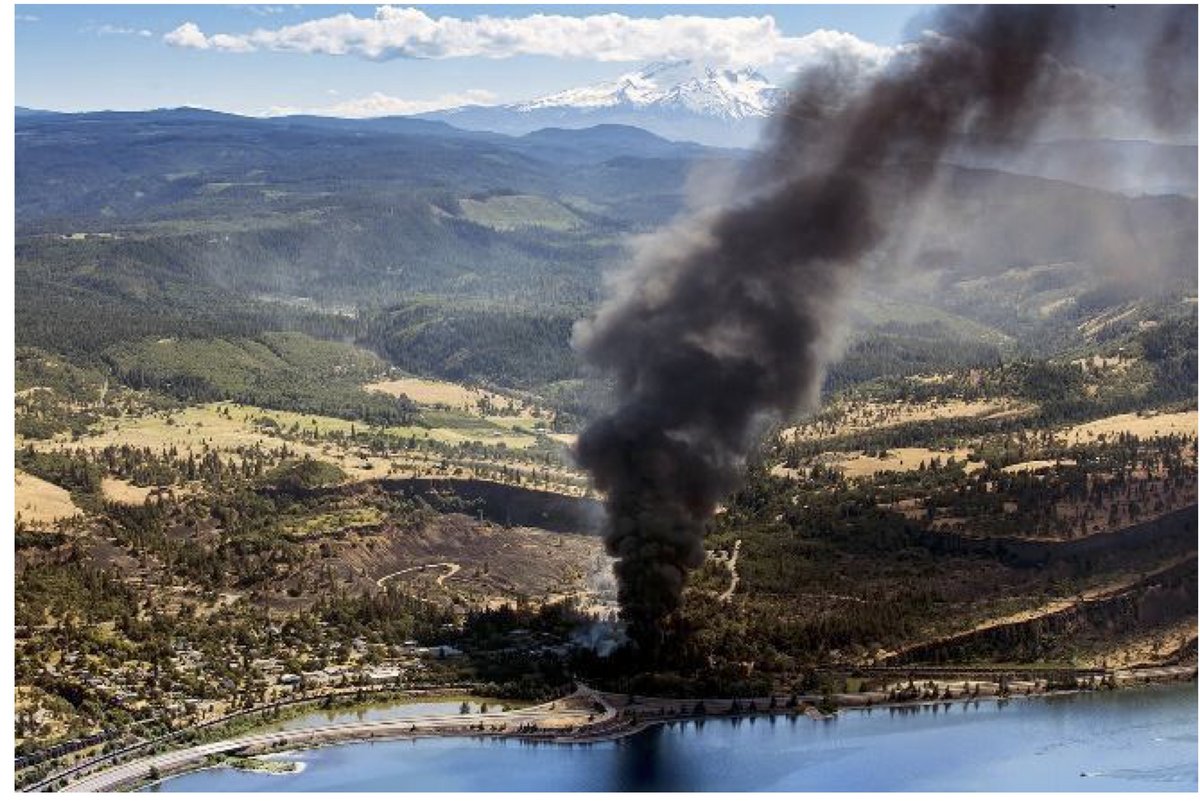
On the first full day of the gathering, an oil train exploded in the Columbia River Gorge, near Mosier, a town not far from Hood River and our gathering site. Within hours, we could smell the burning oil. By the next morning, the smell and sight of oil in the air was so strong, several of our gatherers felt ill. We all felt 'ill' that the accident many had predicted would happen in the Gorge finally did. One person planning to attend could not come because of the travel issues the crash caused.
Fortunately, the oil did not directly enter the river and clean up is, by and large, going well. The accident - this time - was not the massive disaster many feared and continue to fear. The experience rightfully shadowed our conversation the next day, raising more questions than answers. The political, economic, and other systemic forces 'feeding' the need to move oil on trains are strong; where in the system can we find the leverage that will 'drain' this need?
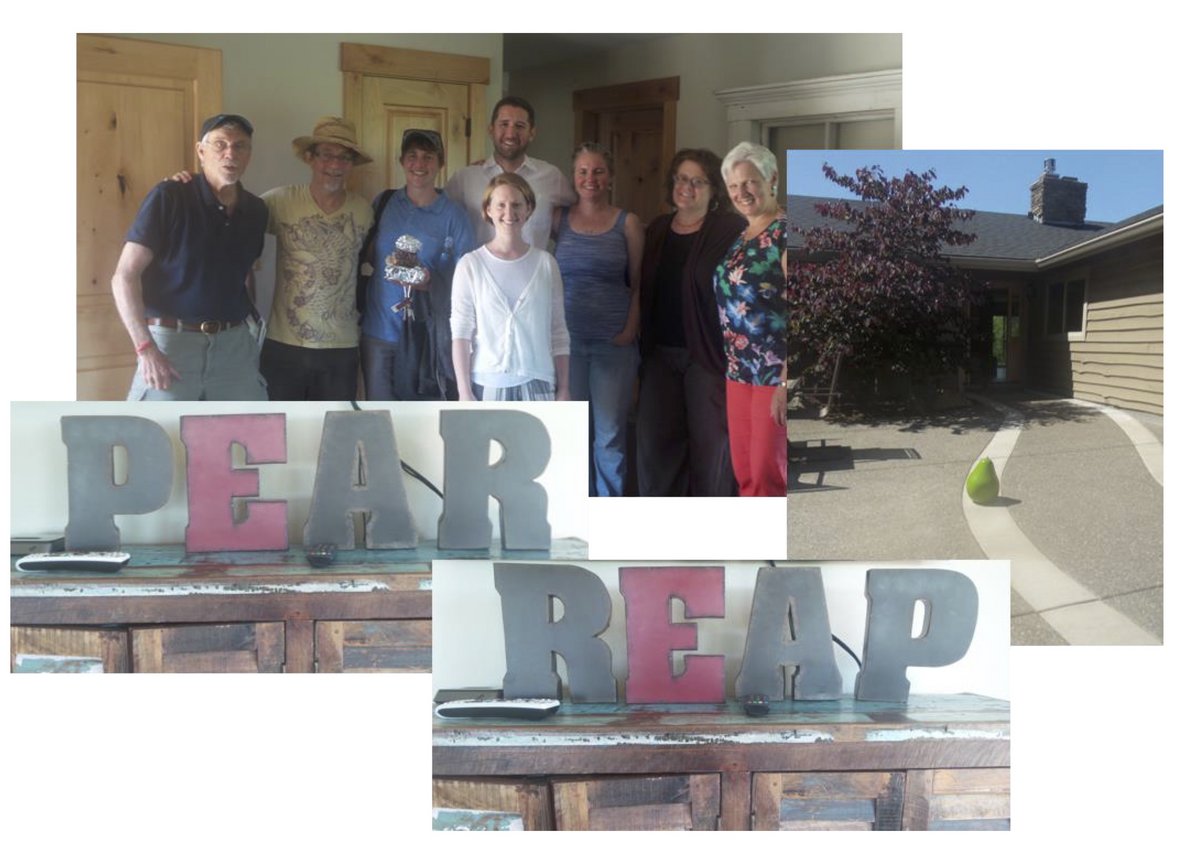
What did we leave with?
'Pausing' brought us great joy, pears and much on which to think and act. Our participants reaffirmed for us the critical nature of this missing piece of work - evoking from communities their innate capability to be smarter, and more effective, together. But their stories and insights also revealed the size of the challenge ahead. Our current social and infrastructural systems do little to support these innate capabilities - we un-learn systems thinking at an early age, learning instead to silo and direct our knowledge in linear ways. We tend to engage far more in competition than collaboration as we move through adulthood and the working world. We are awash in information and yet still hoard it. We talk much more than we listen. Still, this ad hoc 'community' gave us hope, plans, and support. We are immensely grateful for the interest Invoking the Pause showed in us and the nurturing support the Confluence Project provided. We found our form; follow our progress at www.innovation-ecology.io!1 Some gatherers fit in more than one category!
Categories
- All
- #ZeroBy2050
- 10Power
- 350 Seattle
- 36.5
- ANHE
- ARC-KE:i
- Al Gore
- Alicia Escott
- American Resilience Project
- Anjali Nayar
- Anthony Myint
- As You Sow
- At the Water's Edge
- Bard Center for Environmental Policy
- Beka Economopoulos
- Biomimicry Collaborative
- Bioneers
- Black Permaculture Network
- Blossoming Possibilities
- Blue Heart Labs
- Bodhi Garrett
- Britta Riley
- Bureau of Linguistical Reality
- C2C(Change 2 Climate)
- CELI
- COP21
- COP22
- California Foodways
- California Institute for Rural Studies
- Carbon Shock
- Casey Beck
- Catalogue of Extinct Experience
- Cathedral of St. John the Divine
- Center for Investigative Reporting
- Change the Bulb
- Chris Desser
- CityLab7
- Clean Energy Leadership Institute
- Climate Change
- Climate Science Alliance
- Climate Solutions Group
- CoClimate
- Convening 2010
- Coronavirus
- Council of Pronghorn
- Daily Acts
- Dancing Earth
- Dancing Without Borders
- Dr. Renee Lertzman
- Dream Rider Productions
- DreamRider Productions
- Duke University
- E2
- Earth Guardians
- Earthseed Consulting
- Eban Goodstein
- Eve Mosher
- Faith Kearns
- GAIA
- Gary Nabhan
- General
- Global Climate Action Summit
- Grant Partner Gathering
- Grant Partner Spotlight
- Grant Partners
- Grant Proposal Application
- Grants
- Happening
- Heidi Quante
- HighWaterLine
- Human Impacts Institute
- Impact Experience
- Impact Hours
- Invoking the Pause
- Joshua Fouts
- KALW
- KQED
- Kelly McVicker
- Kiss The Ground
- Libby Modern
- Lien Tran
- Lindley Mease
- Lisa Micheli
- Lisa Morehouse
- Magalie Bonneau
- Maggie Kaplan
- Mark Hertsgaard
- Mark Schapiro
- McDonalds
- Monica Wilson
- Morgan Curtis
- Natural History Museum
- Newsweek
- Nicole Heller
- Nicole Lederer
- Nina Simons
- Nina Wise
- Optimist Daily
- Pandora Thomas
- Paris COP21
- Pepperwood Preserve
- Peter Cunningham
- Planet Protector Academy
- Planet Protectors
- Post Pause
- Power Shift Network
- Presidio Graduate School
- Psych Alive
- Rainforest Connection
- Rebecca Patton
- Reinhard Hohlwein
- Rulan Tangen
- SPM3
- Sandra Kwak
- Sarah Cameron Sunde
- Science House Foundation
- Seeding Possibilities
- Seeds of Resistance
- Starbucks
- Stephen Antupit
- Sun Valley Forum
- SustainUS
- TIMBY
- Taco Diplomacy
- Tara DePorte
- Tensorflow
- Terry Tempest Williams
- The Arctic Cycle
- The Natural History Museum
- The Optimist Daily
- The Organic Life
- The Perennial
- The Redford Center
- Topher White
- Transition US
- Trathen Heckman
- Tribal Changes App
- University of Miami
- Videos
- Village Green(er)
- Wildlife Conservation Network
- Windowfarms
- Winters Past
- Works on Water
- World Business Academy
- XSproject
- Xi Martinez
- Zero Foodprint
- invoking the Pause

